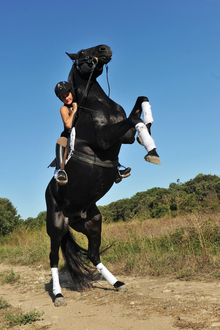My Horse University is featuring another free webcast, Trail Riding Tips included in their Trail Riding 101 course to be presented on Date: May 19, 7 p.m. EDT, by Betsy Greene, professor of animal science and Extension specialist, University of Vermont

Staying safe on horse back
Unlike riding in circles in your arena at home, tackling the trails keeps both you and your horse thinking ahead and really enjoying the experience.
Trail riding provides both horse and rider an opportunity to move off the beaten trail and explore new horizons. Applying the âsafety firstâ motto from leaving home to returning from the trail ride will ensure a great experience. Always think ahead and plan for the unexpected throughout your trip.
Part of the fun of riding trails is encountering the unknown â whether it is a doe and fawn or a biker. Unlike riding in circles in your arena at home, tackling the trails keeps both you and your horse thinking ahead and really enjoying the experience.
Riding With Other Horses
Riding in a group is safer than riding alone. When riding in a group, keep safety in mind and donât crowd other horses. Never ride up on a horse at a faster speed. Make sure and allow at least a horse-length to the horse in front of you.
When transitioning to a faster gait, donât take off in the group. Horses are herd-bound creatures; and if one horse takes off, the other horsesâ natural instinct is to follow.â¨â¨Establish an order to the group. Some horses do better in the front, and others do better in the back at a slower pace.
Horses or riders with less trail experience should be placed in the middle of the group. The more experienced riders and mounts should be placed in the front and rear of the group.â¨â¨The lead rider of the group should notify the other riders of upcoming hazards and changes in pace so that they are aware.
Before trotting or cantering (loping) off, he/she should ask the other riders if they want to trot or canter (lope). Also, when slowing down, they should hold up their hand to signify stop. They should also warn the other riders of any low branches, wildlife or other users on the trail.
In the case of an accident on the trail or a need for an equipment adjustment that requires dismounting, the lead rider should block the trail with his or her horse while the sweep or rear rider tends to the situation.
In a situation requiring first aid, the most trained person in first aid (such as those who have taken a first aid course, a nurse, or other emergency responder) should tend to the rider or horse needing assistance while the lead rider blocks the trail.
If you want to pass members of your group, then itâs polite to inform them as to what side you are passing on. If another group of riders want to pass your group, then find a clear spot in the trail to pull off and let the other group go by.â¨â¨Some organized trail rides do not allow stallions to be ridden with the group.
Many times, mares may become disruptive when exposed to stallions, especially if they are in heat. If stallions are being ridden with a group, they should be kept in the front. Only advanced riders with a great deal of experience handling stallions should ride them.
Free Webcast!
Tips for Staying Safe on the Roads and Trails
As we look forward to getting out and about with our horses, how can we take precautions to minimize bad experiences with people and vehicles on the roads and trails? This webinar will provide information and resources for fun and safe riding experiences.
Date:
Date: May 19, 7 p.m. EDT
Speaker:
Betsy Greene, professor of animal science and Extension specialist, University of Vermont
Click HERE to Register for this FREE webcast!
For a full list of webcasts, CLICK HERE.
